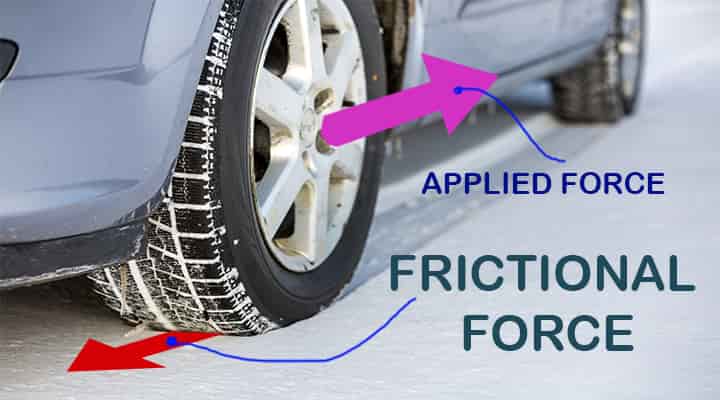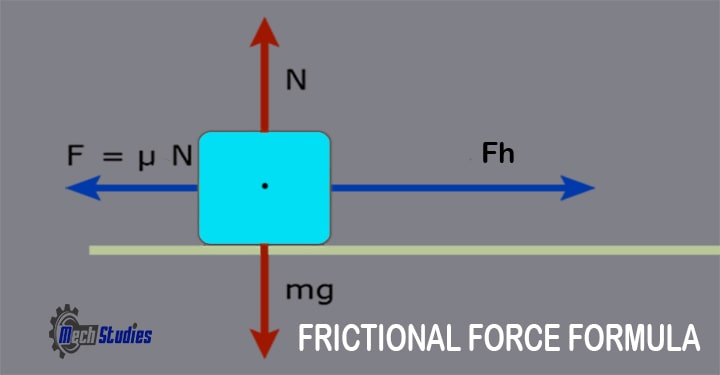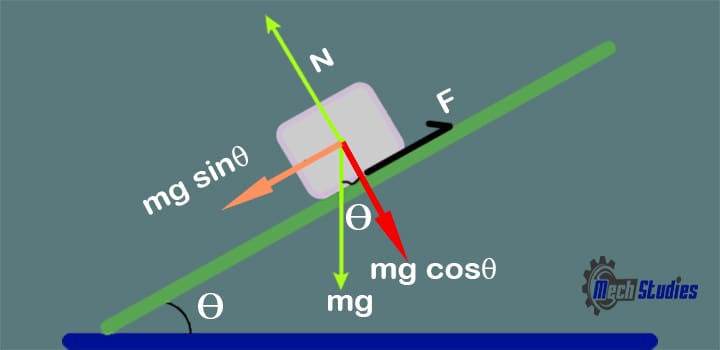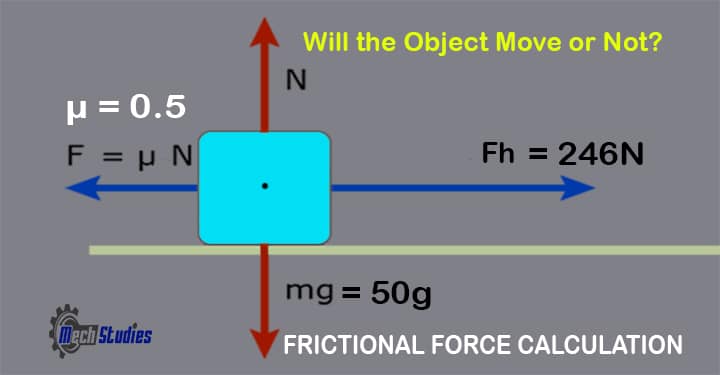What is the force of friction? Any idea! In this article, we will learn the basics of friction, definition, equations or formula, types, along with examples. Let’s explore!
What is Force of Friction?
Force of Friction Concept
As you look around you there are many forces at play doing their own jobs in their respective fields. Take an example of a truck driver driving a truck, when a speed breaker approaches you to hear loud noises and the truck tends to get stopped as he applies the brake.
- So how does a small component weighing not more than a kilogram can stop such a heavy truck from moving at high speed?

That you must be wondering. Well, friction force acts opposite to regular motion, and it retards the movement of the moving object.
Force of Friction Examples
Let take an example of a bicycle where small disc brake help you stop it there also similar force is applied. These are the examples when braking force was applied but what about the places where it is not applied and still the motion of the object comes to standstill.
- We all know that the surfaces of the bodies are never perfectly smooth.
- When a piece of surface is examined under a microscope, we can see that it has roughness and imperfections all over it, regardless of how much that surface was polished, which may not be detectable with the naked eye.
- If any material block is placed on another, it may have the same or different material then also those blocks will get interlocked due to surface irregularities.
This does not involve friction force but as soon as it is moved tangentially over one another force of friction acts and its interlocking property opposes the movement and inhibits the motion.
Friction Force Definition
This opposing force, which operates in the opposite direction of the upper block’s movement, is known as the force of friction or simply friction.
The force of friction is defined as the force generated by two surfaces that contact and slide against each other.
As a result, at every joint in a machine, friction is caused by the relative motion of two components, and therefore some energy is spent in overcoming the friction. Though friction is regarded as undesirable, it plays a significant part in both nature and engineering, for example,
- walking on a road,
- locomotive motion on tracks,
- power transfer via belts, gears, and so on.
For the automobile to go ahead, friction between the wheels and the road is required.
Force of Friction Equation or Formula
Frictional Force Equation or Formula
The frictional force can be easily calculated from the definition,
F= μ N
Where,
- F = The force of friction
- μ = Co-efficient, known as co-efficient of friction
- N = Normal force acting perpendicular to the surface where force is acting.

Hence, Normal force, N,
- N = force acting on the surface
- N = force acting due to weight
- N = mg
Where,
- m = mass of the object
- g = Gravitational acceleration
Hence, considering this weight, the force of friction formula can be written as,
F= μ mg
Now, if the surface is inclined and if it makes an angle θ, then

- Weight component = mg cosθ
- N = Weight component = mg cosθ
Hence, considering this angle, the force of friction formula can be written as,
F= μ mg cosθ
As the frictional force is one type of force, the unit of frictional force will be the same as force.
- S.I Unit of Frictional Force: Newton (N)
- C.G.S Unit of Frictional Force: Dyne (Dyn)
- F.P.S Unit of Frictional Force: lb-f
Coefficient of Friction
It is defined as the ratio of the limiting friction (F) between two bodies to their normal response (N). It is generally denoted by μ. Mathematically, coefficient of friction,
μ = F/N
Its value is different for different materials. As the coefficient of friction is the ratio of two different forces, it will be unitless. For metal between 0.15 to 0.60 while stone 0.40 to 0.70.
How to Calculate Frictional Force?
Calculation Steps
We have got the basic equation for frictional force. It is F= μ Rn. Hence, if we know, Rn and μ, it will be easy to find out the force of friction! Let’s see, how to calculate the frictional force in simple steps?
Step-1: Calculate Normal Force
When an object is kept on a surface, the weight of the object is acting vertically down. The object is stable and the surface is horizontal in our example. Hence, the normal force will act on the surface vertically upwards to balance the weight, which is acting vertically down.
Hence, Normal force, N,
- N = mg
Now, if the surface is inclined and if it makes an angle θ, then
- Weight component = mg cosθ
- N = Weight component = mg cosθ
Step-2: Finding the Value of Coefficient of Friction
The coefficient of friction depends on the type of materials, surface roughness, etc.
For examples,
- Aluminium vs Aluminium surface: μ = 0.3
- Aluminium vs Snow: μ = 0.4
- Cadmium vs Chromium surface: μ = 0.41
- Copper vs Cast Iron surface: μ = 1.05
In this way, we will get the value of μ.
Step-3: Calculate the Force of Friction
So, we have got the value of N and μ.
Now, to get the frictional force, F
- F = normal force x co-efficient of friction
- F = μ N.
Calculation Examples
Let’s see a simple example to understand the frictional force. A copper block of 5kg mass kept on a horizontal cast-iron surface. The copper block is at rest and the frictional factor acts between the copper block and the cast-iron surface is 1.05. Find out the frictional force.
Given data,
- m = Mass of copper block = 5 kg
- g = Gravitational acceleration = 9.8 m/s2
- N = Normal force = weight = mg = 5 x 9.8 = 49N
- μ = Coefficient of friction = 1.05
Hence, frictional force, F
- F = μ x N
- F = 1.05 x 49
- F = 51.45 N
Types of Friction
Static friction
It is the friction that is experienced by a body when it is at rest.
Dynamic friction
It is the friction force experienced by a body when it is moving that is in motion. Dynamic friction is also known by the name kinetic friction and always less than that of static friction. It has three types
- Sliding friction
 – It is the friction that a body experiences as it glides across another body.
– It is the friction that a body experiences as it glides across another body.
- Rolling friction – It is the friction that occurs between surfaces that have balls or rollers placed between them.
- Pivot friction – It is the friction felt by a body as a result of its rotational motion, like in the context of footstep bearings.
The friction may further be classified as:
- Friction between unlubricated surfaces
- Friction between lubricated surfaces.
Unlubricated Surfaces
- Dry or solid friction is the friction that occurs when two dry and unlubricated surfaces come into contact. It is related to the materials’ surface roughness. It is commonly found in footwear or a single plate clutch.
Lubricated Surfaces
Boundary friction (also known as greasy friction or non-viscous friction)
- It is the friction, experienced between the two constantly rubbing surfaces when the surfaces have a very thin layer of lubricant applied in between them.
- The thickness of this thin layer is of molecular dimension. In this type of friction, this thin layer acts as a bonding material between two surfaces.
- The lubricant is absorbed and creates a thin layer on the surfaces. This thin film tries to reduce wear and tear and reduces friction. The boundary friction generally follows the laws of solid friction.
Fluid friction (also known as film friction or viscous friction)
- It is the friction, experienced between the rubbing surfaces when the surfaces have a thick layer of lubricant between the mating surfaces.
- In this case, the surfaces on which it is applied do not allow them to be in contact and hence do not rub against each other. It follows that fluid friction is caused by the viscosity and oiliness of the lubricant rather than the surfaces in contact.
Friction Force with Viscosity & Oiliness
What is viscosity?
- The viscosity of a lubricant is a measure of the resistance it provides when one layer of the lubricant is moved over another. The force required to move a plate of unit area with unit velocity relative to a parallel plate separated by a layer of lubricant of unit thickness is defined as the absolute viscosity of the lubricant.
What is oiliness?
- By comparing two lubricants of comparable viscosity and temperature, the oiliness characteristic of a lubricant may be easily recognised. When these lubricants are distributed over two distinct surfaces, it is discovered that the friction force with one lubricant differs from that with the other.
- This variation is caused by the lubricant’s oiliness characteristic. The lubricant which gives a lower force of friction is said to have greater oiliness.
- The viscosity of a liquid lubricant determines its effectiveness: too thick will create friction and inhibit sliding, while too liquid-like will spread too quickly.
Limiting friction
- Consider there is one body A of weight W, and it is at rest in equilibrium due to its weight. It is lying on the surface of body B. The normal reaction of a force N is acting on body A by body B which is equal to A. Now if a small value of force P is applied to a body passing through its center of gravity, then it should move from its position.
- But it does not move this is because there is a frictional force that is acting on it and it inhibits its motion as it is acting in the opposite direction. This shows the force P is exactly balanced by the force F which is a frictional force. Let’s have 2 conditions until the F > P then the body will continue to be in a state of rest.
- If we increase the force P, then the friction force will also be increased by the same amount. So P2 = F2 is seen here. Thus, every time there will be an increase in the amount of effort to move the body the force of friction will also be increasing to become exactly equal to the force P.
- There is always a limit to such a scenario beyond which the force of friction cannot increase. After this, any increase in applied effort will not lead to any further increase in friction force.
- Thus, this body A will move in the direction of applied force P. A limiting force of friction or limiting friction is the maximum value of the frictional force that comes into play when the body begins to slide across another surface of the body.
- The fact remains that when the applied force is less compared to the limiting force of friction then that friction is called static friction. While when body A will continue to slide over a body that overcomes the resistance offered by body B is called dynamic friction.
Laws of Friction
Laws of Static Friction
1. The frictional force will always act in a direction exactly opposite to the direction of the applied force.
2. The magnitude of the force of friction is exactly equal to the applied force which causes the body to move.
3. The magnitude of the limiting friction (F) forms a constant ratio to the normal reaction (N) between the two surfaces.
Mathematically
F/N = constant
4. The force of friction is not dependent on the area of contact, between the two surfaces.
5. The force of friction depends upon the roughness of the surfaces in between.
Laws of Kinetic or Dynamic Friction
1. The frictional force will always act in a direction exactly opposite to the direction of the applied force.
2. The magnitude of kinetic friction is proportional to the normal response between the two surfaces. However, this ratio is slightly lower than in the case of limited friction.
3. The force of friction remains constant at modest speeds. However, it continues to drop somewhat as the speed increases.
Laws of Solid Friction
1. The friction force is proportional to the normal load between the surfaces.
2. For a given normal load, the force of friction is independent of the area of the contact surface.
3. The friction force is determined by the material of the contact surfaces.
4. The force of friction is independent of the velocity at which one body slides relative to the other.
Laws of Fluid Friction
1. The frictional force is virtually completely independent of the load.
2. The force of friction decreases as the temperature of the lubricant rises.
3. The friction force is unaffected by the materials of the bearing surfaces.
4. The frictional force varies depending on the lubricant.
Limiting Angle of Friction
Consider a body A on the surface of body B. the applied force P is applied over it while force F is the frictional force that resists its movement as it acts in its opposite direction.
- The body will move as soon as P>F.
- The friction force F= μ N.
Where Rn is a normal reaction. Under the influence of three forces, the body will be in equilibrium.
- Weight of body A is W
- Applied force P
- Reaction N between both bodies.
As a result, the reaction R must be equal to and opposite to the product of W and P, as well as inclined at an angle to the normal reaction N. This angle is known as the frictional restriction angle.
It is defined as the angle formed by the resulting reaction R with the normal reaction N.
tan φ = F/N = μ N/ N = μ
The significance of this angle is that the effort P will be minimum if its inclination with the horizontal is equal to the angle of friction.
Applications of Force of Friction
Clutch
The main function of the clutch is the transmission of power from a prime mover to a shaft. It is placed in between the shaft and prime mover and is needed as machines must start and stopped during loading and unloading.
The load also keeps changing. So instead of always switching on or off the prime mover clutch is used.
While in case of automobiles to change gears fluently without jerk it becomes necessary to disengage the power drive. This device gradually brings up the speed.
Its working principle is – when two rotating discs of high roughness when touch each other transfer the power and when they are away transmission is stopped.
Depending on its use clutches are of various types:
- Disc or plate clutch
- Cone clutch
- Centrifugal clutch
Brake
It is a device that is used to stop automobiles or retard after an increased acceleration. Basically, it reduces the speed, this is done by using friction force which is applied by the braking pads on a rotating wheel. Its designing principle is simple.
The highly rough and abrasive material is used as a braking pad which gets rubbed on a wheel drum or brake plate. Depending on their construction it has 2 types.
- Drum brake
- Disc brake
Aerodynamics
It is a branch of engineering which deals with the designing of shapes in such a way that friction on the body gets reduced. Even air offers resistance to a moving body when it travels at high speed thus to reduce this friction aerodynamic shape is given to the vehicle. The design of high-speed trains, sports cars, and aeroplanes are a common example in which designing a body with reduced frictional force is important.
Bearings
To keep friction minimum whilst transferring power by maintaining either point or line contact. A friction bearing is made up of a permanent, non-moving bearing surface, such as machined metal or a pressed-in bushing, that serves as a low-friction support surface for rotating or sliding surfaces. Lubricating oil is often used in friction bearings to separate the moving component from the mated non-moving bearing surface.
| Desirable Friction | Undesirable Friction |
| This leads to loss of energy but that’s the end goal. Ex breaking vehicle | It leads to loss of energy but that’s not end goal. Ex propulsion of aircrafts, missiles. |
| It leads to wear and tear of object, but here done to remove material. Ex grinding machine | It leads to wear tear of object. Ex machines gears |
| Designing principle for specific gadgets. Ex clutch, brake | It is avoided by use of other substance. Ex lubricant, grease |
Frictional Force Sample Calculation Example
Question
A 50 kg metal object on a horizontal desk is pushed by a horizontal force
of 246 N. The frictional factor is 0.5. Determine whether the metal object will move or not.

Solution
Given data: From the question, we can write the given data,
- m = Mass of metal object = 50 kg
- N = Normal force = mg = 50 x 9.8 N
- Fh=Horizontal force = 246 N
- μ = Frictional factor = 0.5.
What to prove? We need to check whether the metal object will move or not.
Explanation: The metal object is kept on a horizontal surface, and obviously, the frictional force is acting between the object and the surface.
Now, there may be two options,
- If the applied force is more than frictional force, then the object will move.
- If the applied force is less than the frictional force, then the object will not move.
Calculation & Proof: First, we will calculate, the frictional force, F
F = μ N
F = 0.5 x 50 x 9.8
F = 245 N
This is less than the applied horizontal force, Fh=246 N.
F < Fh
Hence, the metal object will move.
Conclusion
Hence, we have got an idea about frictional force. Any questions, please let us know.

